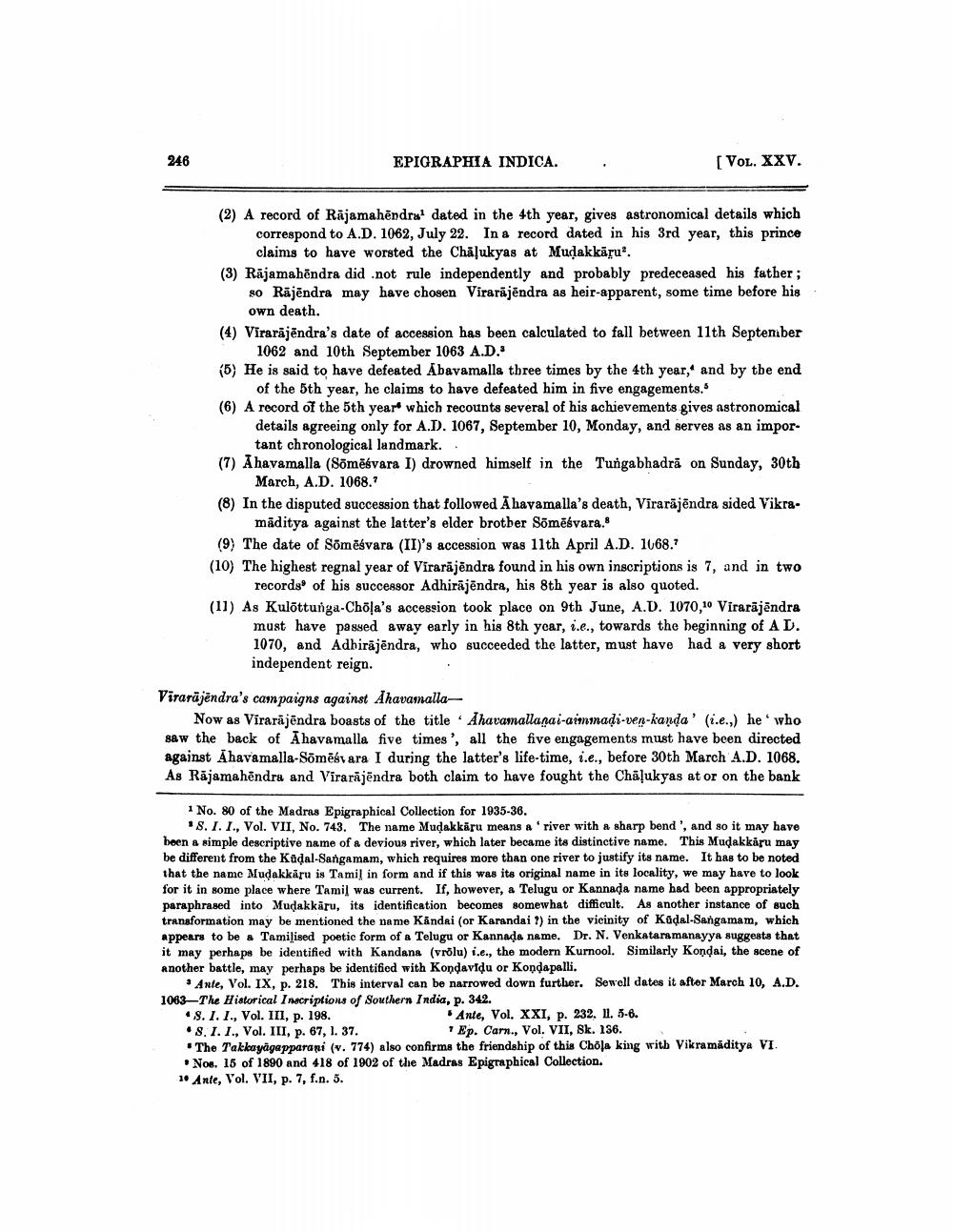________________
246
EPIGRAPHIA INDICA.
[VOL. XXV.
(2) A record of Rajamahēndra dated in the 4th year, gives astronomical details which
correspond to A.D. 1062, July 22. In a record dated in his 3rd year, this prince
claims to have worsted the Chāļukyas at Mudakkāru". (3) Rājamahēndra did not rule independently and probably predeceased his father ;
so Rājēndra may have chosen Virarājēndra as heir-apparent, some time before his
own death. (4) Virarājēndra's date of accession has been calculated to fall between 11th Septeniber
1062 and 10th September 1063 A.D. (5) He is said to have defeated Abavamalla three times by the 4th year, and by the end
of the 5th year, he claims to have defeated him in five engagements. (6) A record of the 5th years which recounts several of his achievements gives astronomical
details agreeing only for A.D. 1067, September 10, Monday, and serves as an impor
tant chronological landmark.. (7) Ahavamalla (Sõmēsvara I) drowned himself in the Tungabhadrã on Sunday, 30th
March, A.D. 1068.? (8) In the disputed succession that followed Ahavamalla's death, Virarājēndra sided Vikra.
māditya against the latter's elder brother Sõmēsvara. (9) The date of Sõmēsvara (II)'s accession was 11th April A.D. 1068.7 (10) The highest regnal year of Virarājēndra found in his own inscriptions is 7, and in two
records of his successor Adhirājēndra, his 8th year is also quoted. (11) As Kulõttunga-Chola's accession took place on 9th June, A.D. 1070,10 Viraräjëndra
must have passed away early in his 8th year, i.e., towards the beginning of AD. 1070, and Adhirājēndra, who succeeded the latter, must have had a very short independent reign.
Virarājēndra's campaigns against Ahavamalla
Now as Virarājēndra boasts of the title * Ahavamallanai-aimmadi-ven-kanda' (ie.,) he who saw the back of Ahavamalla five times', all the five engagements must have been directed against Ahavamalla-Sömēsvara I during the latter's life-time, i.e., before 30th March A.D. 1068. As Rajamahendra and Virarājēndra both claim to have fought the Chalukyas at or on the bank
1 No. 80 of the Madras Epigraphical Collection for 1935-36.
'S.I.I., Vol. VII, No. 743. The name Mudakkāru means a 'river with a sharp bend ', and so it may have been a simple descriptive name of a devious river, which later became its distinctive name. This Mudakkāru may be different from the Kādal-Sangamam, which requires more than one river to justify its name. It has to be noted that the name Mudakkäru is Tamil in form and if this was its original name in its locality, we may have to look for it in some place where Tamil was current. If, however, a Telugu or Kannada name had been appropriately paraphrased into Mudakkāru, its identification becomes somewhat difficult. As another instance of such transformation may be mentioned the name Kändai (or Karandai ?) in the vicinity of Kudal-Sangamam, which appears to be a Tamilised poetic form of a Telugu or Kannada name. Dr. N. Venkataramanayya suggests that it may perhaps be identified with Kandana (vrolu) i.e., the modern Kurnool. Similarly Kondai, the scene of Another battle, may perhaps be identified with Kondavidu or Kondapalli.
• Ante, Vol. IX, p. 218. This interval can be narrowed down further. Sewell dates it after March 10, A.D. 1063—The Historical Inscriptions of Southern India, p. 342. .8. 1. ., Vol. III, p. 198.
Ante, Vol. XXI, p. 232. 11. 5-6. .8.1. I., Vol. III, p. 67, 1. 37.
7 Ep. Carn., Vol. VII, Sk. 186. • The Takkayagapparani (v. 774) also confirms the friendship of this Chola king with Vikramaditya VI. . Nos. 15 of 1890 and 418 of 1902 of the Madras Epigraphical Collection. 1. Ante, Vol. VII, p. 7, f.n. 5.




